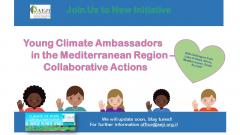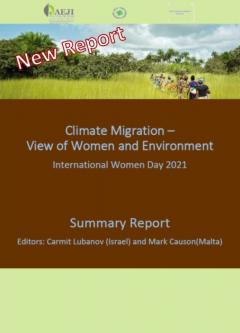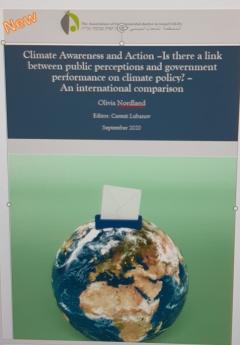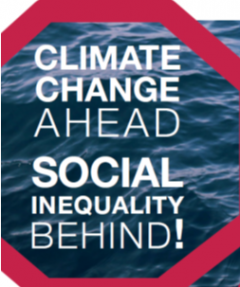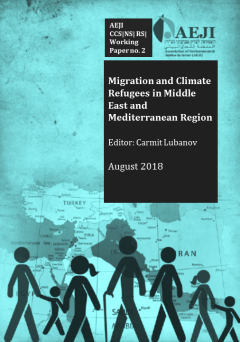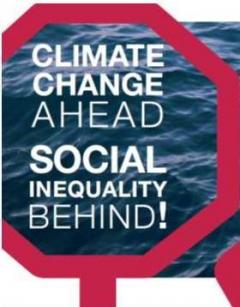Activity FieldsActivities of The Association of Environmental Justice in Israel
Climate Young Ambassadors in Mediterranean Region
New Initiative by AEJI
Carmit Lubanov, Association of Environmental Justice in Israel (AEJI)
| Friday, 02-Aug-2019
New Initiative of AEJI
"Climate Young Ambassadors in the Mediterranean".
Conceptualized and formulated by Carmit Lubanov, AEJI' executive director, 2019
aeji_climate_ambassadors_initiative_in_mediterranean_august2019.pdf
Young Climate Ambassadors in the Mediterranean by AEJI
Climate Migration – View of Women and Environment
Summary Report on the occasion of International Women Day 2021
Carmit Lubanov (Israel), Dr. Mark Causon(Malta)
| Thursday, 18-Mar-2021
Although "Climate migration" is the result of a double and ongoing crisis that has befallen the world in recent years - the climate change and the forced migration – this field has not researched widely and the international institutions not yet recognized for climate refugees.
The world is witnessing extreme climate events occur in different regions of the world - massive floods and severe droughts that claim human lives, forcing entire communities to abandon their place of residence and move to a safer place. Some, especially the young, are even abandoning their homeland and trying their luck to migrate to Western countries to ensure themselves and their families a more secure future. The Mediterranean has become a destination of migration routes from Africa, the near and far East, Afghanistan, Syria, Iraq and other countries characterized by wars, political persecution and civil rights violations, including women and children.
The northern Mediterranean countries today and to a limited extent the southern Mediterranean countries have in the last two decades become a destination for many migrant groups and serve as 'transit stations' for many of them on the way seeking for to a better safer future.
The field of climate migration by definition is multidisciplinary and requires cooperation between international institutions and countries, humanitarian organizations and police authorities, civil society organizations and governments to offer an outline of economic development and social integration of immigrants, forced migration, with forced absorption, sometimes without resources.
Anna Lind Foundation (ALF) recently awarded a research grant to a group we are among its initiators for "Climate Change and Migration in Euro-Med region: Socio-Economic Development and Intercultural Perspective" headed by the University of Calabria (Italy) and with the participation of Association for Environmental Justice (Israel), Genista Research Foundation (Malta), Università d'Annunzio Chieti-Pescara (Italy), FHIRD- Farhat Hached Institute for Research and Democracy (Tunisia) and IMDI - Institute Migration Development and Integration (Albania). This grant is aimed for initial research, in which we will hold a workshop at the end of May 2021.
For us, who initiated the event and are part of a group of researchers and heads of organizations dealing with both climate policy aspects in the Mediterranean, and the issue of migration absorption in the Mediterranean countries - it is clear that it is important to raise climate migration on the agenda, on the academic arena, in front of decision-makers at the state and international level and among activists for civil rights and social justice.
The event we held on March 8, to mark International Women's Day, aims to raise awareness of the issue of climatic migration, and to be part of constructing a new discourse on the subject that includes both the affected geographical regions, such as Lake Chad in the African continent, and the migration absorption regions in southern Europe, such Albania and Portugal - while focusing on Women population, which according to a BBC study constitutes 85% of global climate migrants.
Climate Awareness and Action – Is there a link between public perceptions and government performance on climate policy? – An international comparison
Public Perceptions and Climate Strategy | AEJI Synthesis Report No. 2 | September 2020
Olivia Nordland, Editor: Carmit Lubanov
| Monday, 21-Sep-2020
On the occasion of Climate Week 2020, the Association for Environmental Justice in Israel publishes a new study that examines the complex relationship between climate awareness and perceptions and the ambition of climate policy in specific countries via reviewed the literature that gathered the results of key international climate awareness polls that took place for the last 5 years. By observing factors that influence climate awareness and concern at the global and regional level, and by examining climate perceptions and mitigation policy in several countries, the new research provides better understanding for the critical discourse on the link between public climate awareness and political climate action in a particular country and in the global arena.
Our messages for Climate Week 2020:
#Vote_for_Climate
#Climate_Education_for _Climate_Policy
aeji_climate_awareness_and_government_performance_on_climate_policy_international_comparison_september_2020.pdf
New report: Is there a link between public perceptions and government performance on climate policy? – An international comparis
The 3R of Climate Migration in the Middle East and EasternThe 3R of Climate Migration in the Middle East and Eastern Mediterranean Region – Refugees, Risks, Resilience
Carmit Lubanov, AEJI
| Tuesday, 23-Oct-2018
The 3R of Climate Migration in the Middle East and Eastern Mediterranean Region –
Refugees, Risks, Resilient
Introduction
More than 500 million people live in the Middle East and North Africa. As the recent public discourse has evolved following latest IPCCC report[1] focusing on the threshold of global warming to the point where irreversible catastrophic changes could be prevented (1.5 centigrade Celsius compared to 2). The report was published at the end of the summer season (Northern Hemisphere), where the temperature during this period is already very hot in Middle East and North Africa, and will increase more than two times faster compared to the average global warming. In combination with increasing air pollution by desert dust, the environmental conditions could become intolerable and may force people to migrate[2].
The context and terminology of climate migration and refugees
Evaluating of the diverse refugees groups in the Middle East - in the prism of climate change - provides distinctive platform for studying and discussing in the academic arena and public discourse, in order to construct the long-term policy of ‘Climate migration and refugees’, in partnership with different stakeholders from neighboring countries and the international community.
A new initiative of Climate Justice in regional scale[3] was established by AEJI in 2017, aimed ‘to mitigate the climate risks and adaptation to climate security’. The research of ‘climate migration and refugees’ is part of this initiative. AEJI study has been indicating on 2 categories of ‘refugees groups’ in the Middle East and the Eastern Mediterranean Basin that should be in focus.
Firstly, brief introduction with the terminology are prevailing in the international community and international law.
The different terms in regarding to people who displaced by environmental degradation and climate change according to UNEP should be called “environmental refugees”, “environmental migrants” or “environmentally displaced people”. Each definition has real implications for the obligations of the international community under humanitarian law and the rights of the people displaced (UNEP, 2016). However, the use of the word “refugee” to describe those fleeing from environmental pressures is not accurate under international law. The majority of people forced out of their homes by environmental change will likely stay within their own borders, but there may be no possibility of return to areas that turn to be non-habitable. The difficulty regarding acceptable international definition is explained by few reasons including lack of an adequate term, long term process of displacement, difficulties with collecting data and uncertainties on their numbers. In many cases, unable to prove political persecution in their country of origin, the migrants/refuges fall through the cracks in international humanitarian law. UNEP uses the term “environmental displacement”, although acknowledging that it is not a universally accepted term.
We have adopted in our project the terms ‘climate refugees’ and ‘climate migrants’ as reflecting wide phenomena of forced population displacement linked to environmental degradation following climate change. We expand the discourse of climate change by adding the legal term in use of ‘refugees’, as is politically recognized in the Middle East, linked to Israel-Palestine conflict. Therefore, the 2 defined categories are:
1) Climate refugees – i.e. forced migration on the backdrop of environmental degradation, especially frequent occurrences of droughts, increasing of dust storms, accelerating loss of agricultural land, threatening on food security in Africa and the Middle East.
2) Refugees groups who associated with the Israeli-Palestinian conflict or other wars in the region (for example Iraq, Syria). The majority of those groups have been living in temporary or permanent refugee camps for decades, characterized with poor infrastructures. The predicted climate change in the region include the expansion of the arid areas, increase in number of hot days per year compared to previous decades, intense dust storms - all will severely impact on the living conditions of refugees in designated camps and neighborhoods, without adjusted infrastructure. Those ‘wars refugees’ will be exposed in a much more severe way to climate change, compared to other population groups in neighboring areas, in turn enhancing their vulnerability for the physical surrounding that will be affected by the climate change, and meet them as one of the less resilient population group in the region, in both terms of environment and political stability.
[1] IPCC report, September 2018
[2]Jos Lelieveld, (2016) https://www.mpg.de/10481936/climate-change-middle-east-north-africa
[3]Levant, Eastern Mediterranean Basin
aeji_the_3r_of_climate_migration_in_the_middle_east_and_eastern_mediterranean_region_wp_no.3_2018.pdf
Climate Migration and refugees in the Mediterranean
Migration and Climate Refugees in the Middle East and Mediterranean Region
AEJI CCS |NS|RS Working Paper no. 2:
The Association of Environmental Justice in Israel (AEJI)
| Thursday, 16-Aug-2018
This working-paper is part of Association of Environmental Justice in Israel (AEJI) policy-research on climate change in regional scale, aims to develop discourse on climate migration on public arena, and to provide analysis as a base for policy making assessments of "Climate Change and Security“ in Israel and the Middle East in order that social and human rights considerations will be integral part of policy making process on national, regional and international levels.
The multi-linkages that are between climate change and national security, and between cross-borders environment and human rights are all analyzed and discussed vis-à-vis the current geopolitical landscape and associated transboundary challenges in the East Mediterranean region.
The 1st report titled “Mitigation of Climate Risk and Adaptation to Climate Security in Israel and the Middle East: Policy Measures toward Geopolitical Cooperation and Regional Transformation” [researcher Joel Gordon, supervisor Carmit Lubanov], was published last year framing the full spectrum of actual climate security threats and challenges. The study employs the Intergovernmental Panel on Climate Change (IPCC) framework of "Climate Mitigation and Adaptation" to assess prospects for climate-security in the region. The paper is based on preliminary findings correlate Israel’s potential role in climate-security politics to positive economic benefits. To our view, Climate Change Leadership (CCL) offers an alternative pathway for regional cooperation and geopolitical stability through the advance of Middle Eastern-Mediterranean Alliances (MEMA’s). Furthermore, we propose this vision aligns to a core strategic national masterplan - Leveraging for Geopolitical Cooperation and Regional Transformation – designed to strengthen Israel’s national commitment towards a Climate Compatible Future (CCF). In order to achieve this future, Israel with the neighboring countries and the Mediterranean climate community must to focusing on migratory pressures and climate refugees, to advance geopolitical cooperation and regional transformation in order to be able to challenges the Climate Migration.
The working-paper raises the key topics in five sections. The full research of AEJI on migration and climate refugees in the Middle East and Eastern Mediterranean region will be published in the coming year.
migration_and_climate_refugees_aeji_working_paper_no2_2018_final.pdf
Migration and Climate Refugees in Africa, Middle East and Mediterranean Region
Climate Justice in the Middle East – ME
ClimateJustice.ME
Association of Environmental Justice in Israel (AEJI)
| Thursday, 23-Nov-2017
Since the impact of Climate Change in Middle-East (ME) region is predicted to be on wider scale than single country borders, and targeting mitigation of climate risks should be to our view a shared target and efforts for regional transformation by neighboring countries, governments, researchers and civic society organizations - AEJI has established Climate justice group to act regionally.
Join Us : ClimateJustice.ME
climate_change_in_the_me_introduction.pdf
Climate Change in the Middle East _Basis for regional cooperation


